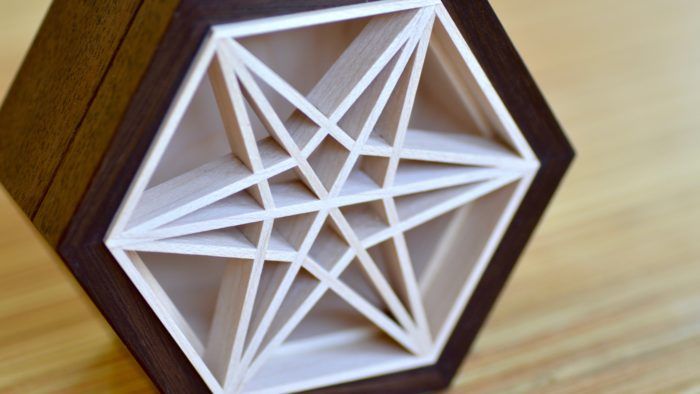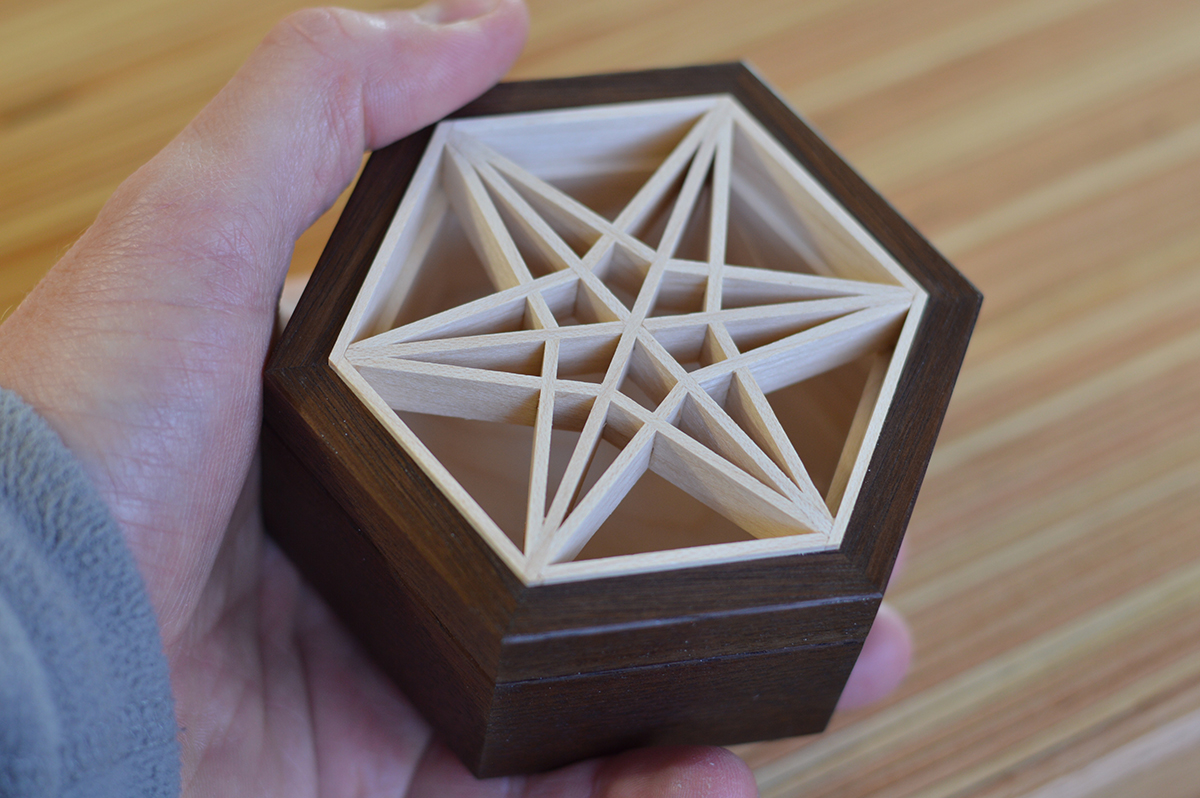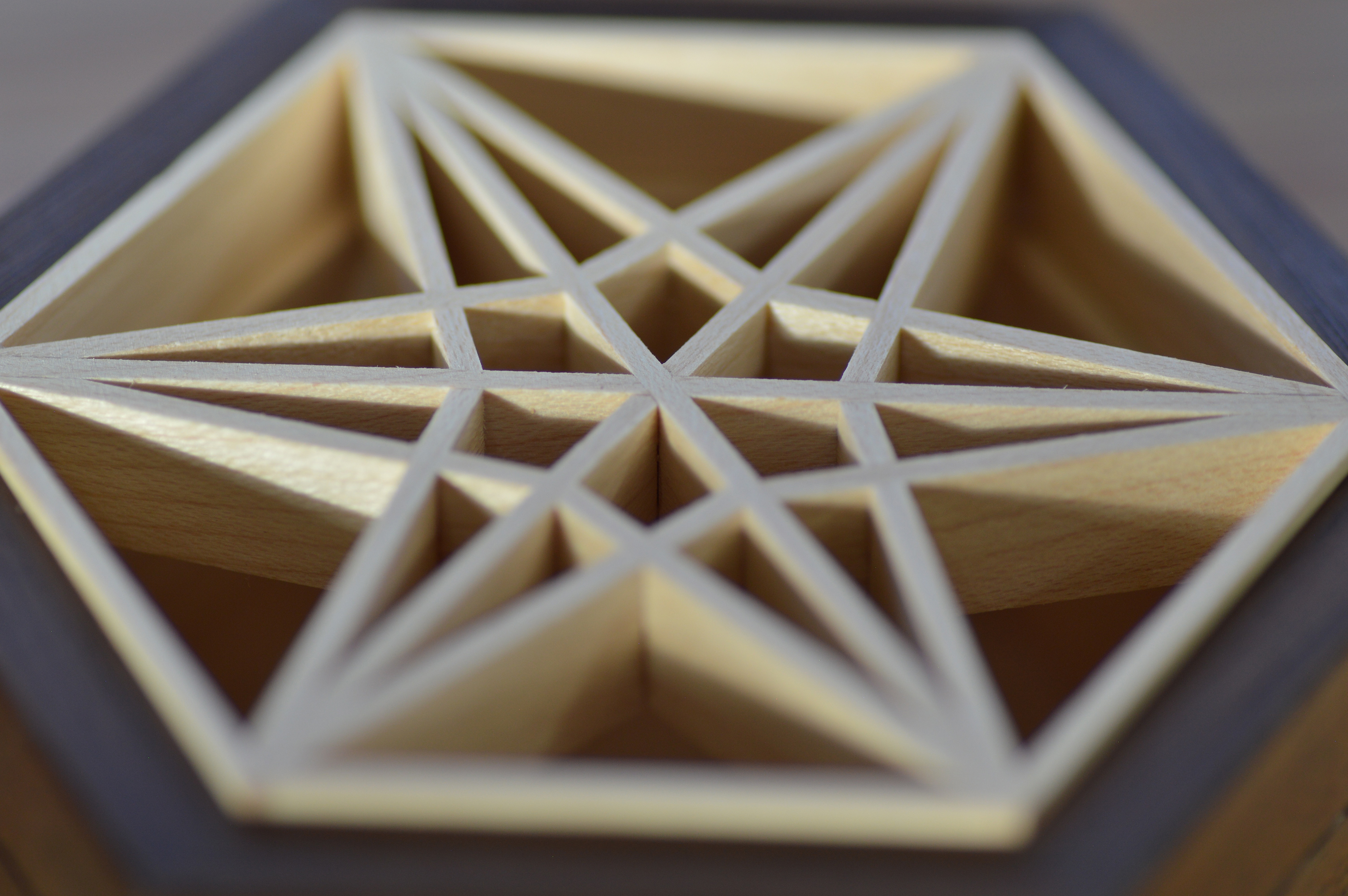저도 교육을 할 당시 수공구의 중요성을 매우 강조해 왔습니다.
하지만 경험에 의하면 특히 초보 시절에는 대부분 목공기계에 대한 욕심이 큽니다. 기계가 모든걸 해결해 주지 않는 다는 사실을 깨닫는데는 많은 시간이 걸리는 것 같습니다.
결국 기계가 없으면 아예 하지 못하는 것과 수공구를 잘 다뤄 시간이 좀 더 걸리더라도 할 수 있는 것과는 큰 차이가 있습니다.
평소 잘 갈고 닦은 수공구의 실력은 결과물의 디테일에서 차이가 날 수 밖에 없습니다.
트레이닝을 위한 효과적인 작업은 뭐니뭐니해도 함이 아닐까 생각합니다. 형태에 따라 다양한 기법들을 적용할 수 있으니까요.
Start Small, Learn Big
If you are a woodworker looking to improve your skills, Mike Farrington suggests that you intersperse some small projects, like boxes, into your work.
시작은 작지만 배움은 큰
만약 당신의 목공 능력을 향상시키고자 한다면, Mike Farrington씨는 함 같은 작은 작업을 해보라고 제안합니다.

I recently made a small box with a kumiko panel in the lid. I used a pattern known as Kasane Rindo. Don’t hold me to this, because I’m prone to changing my mind on a whim, but this is my favorite pattern. I think it looks good as a single unit or in a large formation of many. I’ve had this idea in the back of my head for quite some time. I wanted to make a six-sided box using this pattern in the lid. So leading into the holidays as my business slowed, I found some time to build this box.
나는 최근에 뚜껑에 구미코 패턴이 있는 작은 상자를 만들었습니다. Kasane Rindo로 알려진 패턴을 사용했어요. 내가 변덕이 심해 자주 마음을 바꾸는 경향이 있지만 이것은 내가 가장 좋아하는 패턴입니다. 패턴 하나로도 좋고 여러 패턴이 모여있어도 좋다고 생각합니다. 나는 꽤 오랫동안 이 생각을 머릿속에 품고 있었습니다. 나는 뚜껑에 있는 이 패턴을 이용해서 육각 상자를 만들고 싶었습니다. 그래서 휴일이 시작되어 업무에 여유가 생기자 나는 이 상자를 만들 시간을 갖게 되었습니다.

If you are a woodworker looking to improve your skills, as we all are, I strongly suggest you intersperse some small projects into your work. They are a great place to learn new skills and hone old ones. They’re low stress and perfect for experimentation.
만약 여러분이 우리 모두가 그렇듯이, 여러분의 목공 능력을 향상시키려면, 나는 여러분에게 작은 프로젝트들을 작업에 접목시킬 것을 강력히 제안합니다. 그것은 새로운 기술을 배우고 오래된 기술을 연마하기에 좋은 방법입니다. 스트레스도 적고 다양한 실험에도 적합합니다.
For example, if you want to learn to cut dovetails, try building a small dovetailed box first, instead of a 12-drawer chest with hundreds of dovetails. I find that when learning a new skill, small victories really help keep enthusiasm high. This in turn brings me back for more. Same goes for improving old skills. While building this box I wanted to hone my skills at the shooting board. I wanted to be able to create six joints (12 bevel cuts) that all fit together with zero gaps. This box, with its six small joints, was a great place to slow down and focus on perfecting each step until the end result was just where I wanted to be. A few months from now I will apply these same skills on a larger scale while building a piece of furniture I have in the queue. It’s a large cabinet that will have bevel joints at the corners. I will feel confident going into this build after having had a good experience with the small project first.
예를 들어, 도브테일(주먹장) 가공방법을 배우고 싶다면 수백 개의 도브테일(주먹장)이 있는 12개의 서랍 상자 같은 작업 대신 작은 도브테일(주먹장) 상자를 먼저 만들어 보세요. 나는 새로운 기술을 배울 때 작은 성취가 열정을 높이는 데 큰 도움이 된다는 것을 알게 되었습니다. 그 작은 성취감은 다시 나에게 더 많은 것을 가져다 줍니다. 오래된 전통기술을 향상시키는 것도 마찬가지입니다. 이 상자를 만들면서 나는 목공기술을 더 연마하고 싶었습니다. 틈 없이 잘 맞는 6개의 조인트(12개의 베벨 컷)를 만들고 싶었습니다(육각형). 육각 형태의 이 박스는 내가 원하는 최종 결과가 있을 때까지 천천히 각 단계를 완벽하게 만드는 데 집중할 수 있는 좋은 작업이었습니다. 앞으로 몇 달 후 이 기술을 내가 만들고 싶은 더 큰 규모의 작업에 적용할 계획입니다. 그것은 모서리에 베벨 이음새가 있는 대형 캐비닛입니다. 먼저 이런 작은 작업을 충분히 경험해본 후에 대형 캐비닛을 만들 때에는 더 큰 자신감이 생길 것입니다.
Along these same lines, author and wizardly woodworker Matt Kenney came up with the grand idea to build 52 boxes in 52 weeks. My first reaction to this idea was that is was a wild idea, probably hatched from an evening of too many libations. After thinking more and listening to Matt talk about his reasoning and what he hoped to achieve via this undertaking, I realized something very important. He had come up with an idea, a plan really, to help him learn something. He wanted to work on his design aesthetic as well as his very high level box-making skills. I’m sure he learned many more things along the way but the larger point is he set a specific course for learning and he did it by making a bunch of small projects.
이와 같은 맥락에서 작가이자 굉장한 목공인 Matt Kenney는 52주 동안 52개의 상자를 만들겠다는 원대한 아이디어를 생각해 냈습니다. 이 아이디어에 대한 나의 첫 반응은 아마도 너무 많은 술을 마신 저녁에 떠올린 엉뚱한 아이디어라 생각했습니다. Matt Kenney는 더 생각한 후 자신의 생각과 이 작업을 통해 이루고자 하는 소망에 대해 이야기하는 것을 듣고 나는 매우 중요한 것을 깨달았습니다. 그는 무언가를 배우기 위해 정말로 도움이 되는 아이디어를 생각해낸 것이었습니다. 그는 아름다운 디자인과 기술적으로 매우 높은 수준의 박스 제작 기술을 연구하고 싶어했습니다. 그 과정을 통해 더 많은 것을 배울 것이라 확신하지만, 더 큰 핵심은 그가 구체적인 학습 과정과 목표를 정하고 작은 작업들을 많이 해보면서 그것을 실천했다는 것입니다.

My motivation for making this kumiko box is the same as Matt’s, except 1/52 the size, in that I came up with a project that forced me to focus on a specific skill. Now I could have just cranked out a bunch of test pieces, but that’s not nearly as fun, plus it’s great to have a small project to sell or give to a friend.
If you’d like to see me build this Kumiko box, have a look at the link below. I use my tablesaw technique to cut the three-way lap joints for the kumiko panel, which also happens to be a Fine Woodworking article (issue 274).
이 쿠미코 박스를 만든 동기 Matt Kenney는 1/52 크기만 빼고는 내가 만든 것과 똑같습니다. 특정 기술에 집중할 수밖에 없는 작업을 고안했다는 점에서요. 테스트용 조각들을 잔뜩 만들 수도 있었는데, 별로 재미도 없고, 판매하거나 친구에게 줄 작은 작업을 하는 것이 좋습니다.
내가 이 쿠미코 박스를 만드는 것을 보고 싶다면 아래 링크를 보세요. 나는 테이블쏘를 사용하여 구미코 판넬의 3방향 턱을 가공합니다. 이것은 Fine Woodworking 기사(274호)에도 있습니다.
 [HOW-TO] 목재의 밴딩 기법을 활용한 테이블
[HOW-TO] 목재의 밴딩 기법을 활용한 테이블
 [HOW-TO] 싸이클론 집진기 만들기
[HOW-TO] 싸이클론 집진기 만들기












